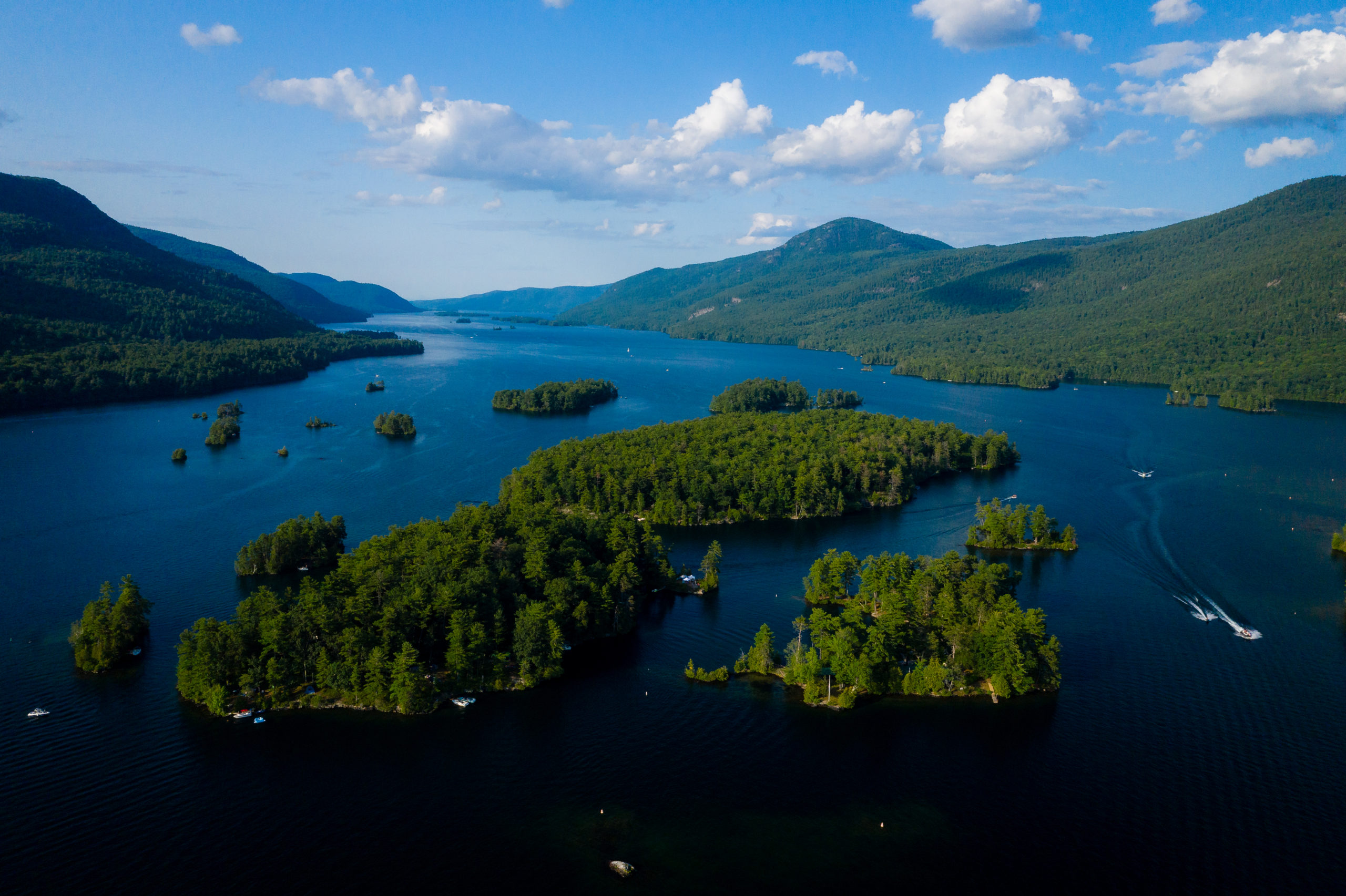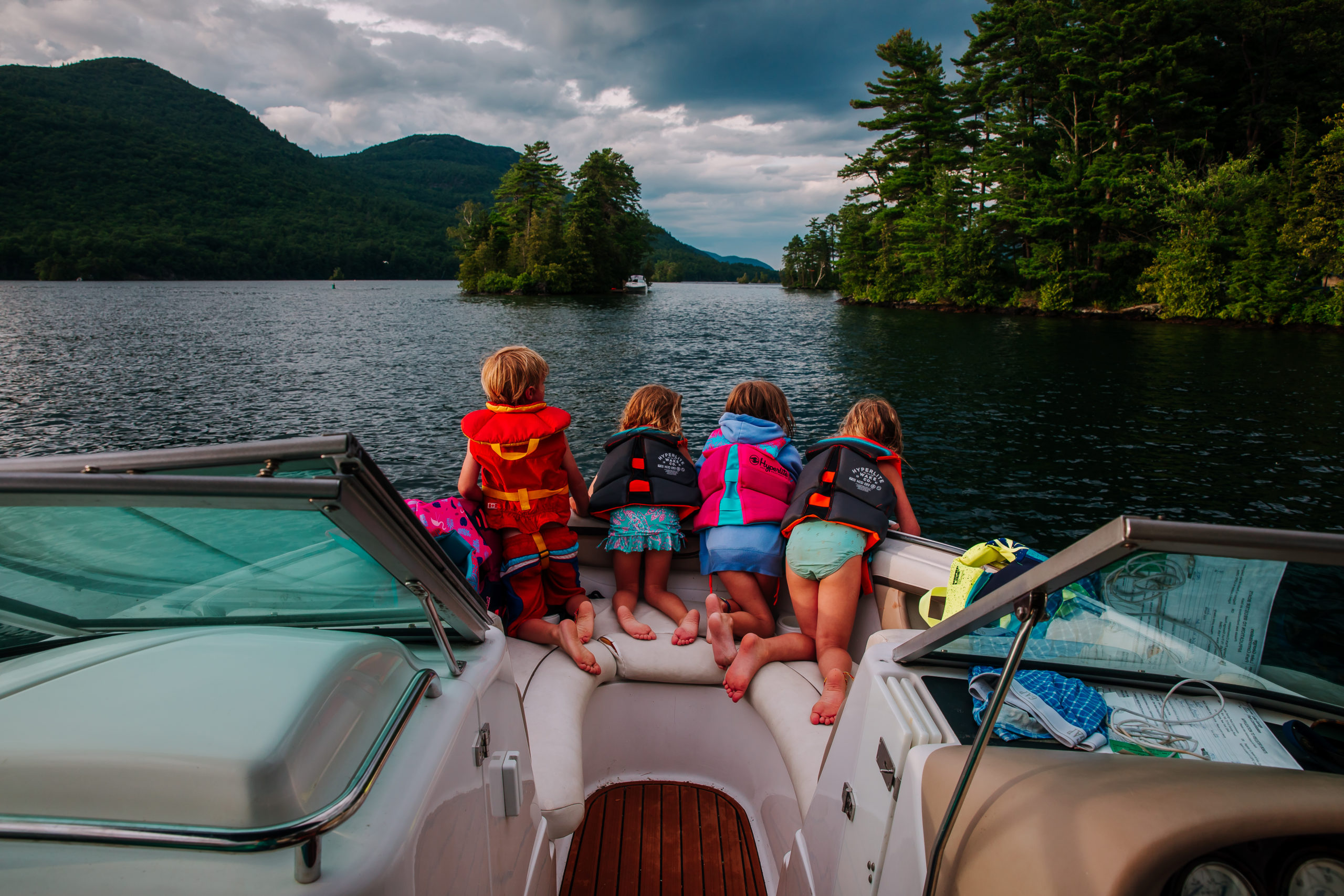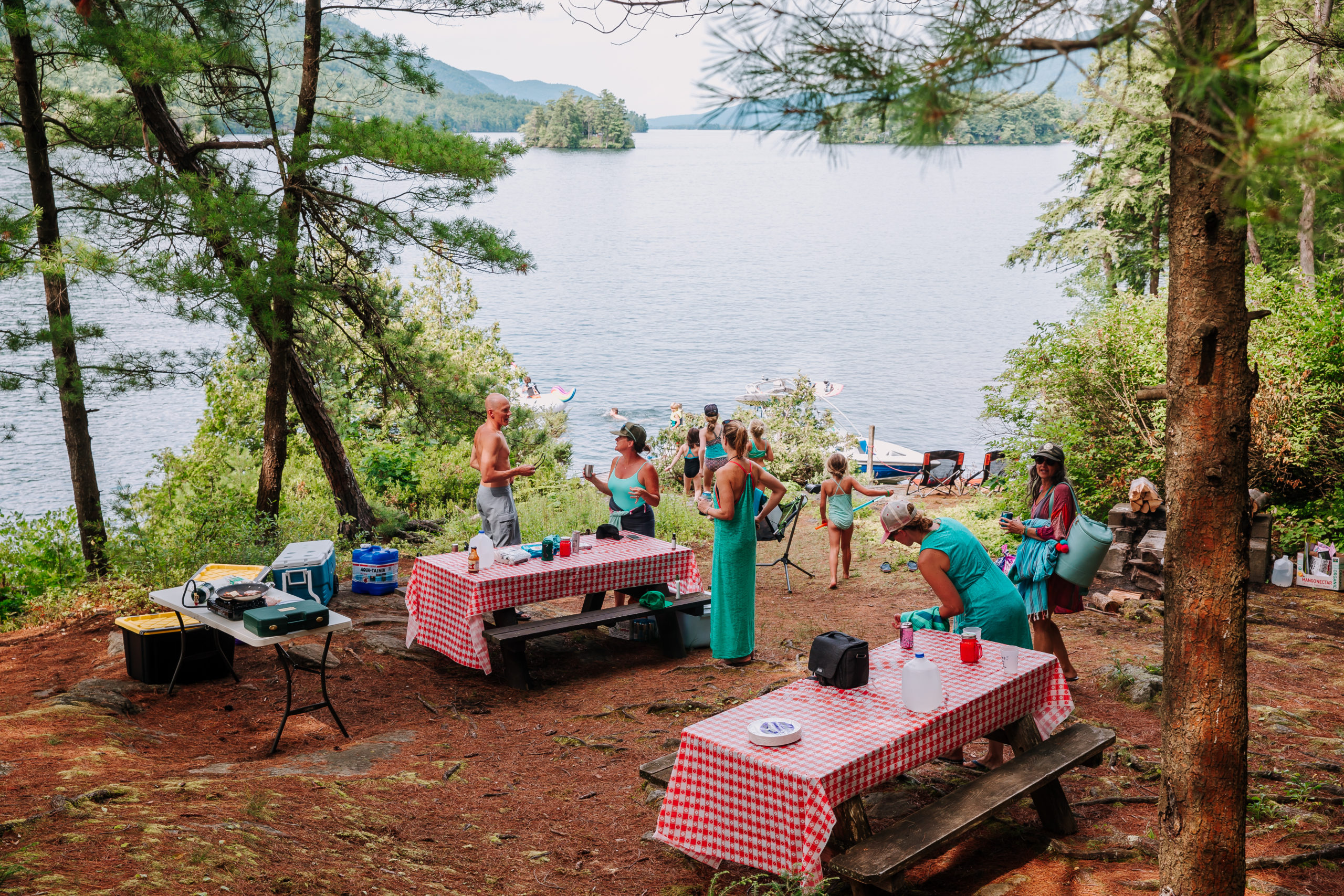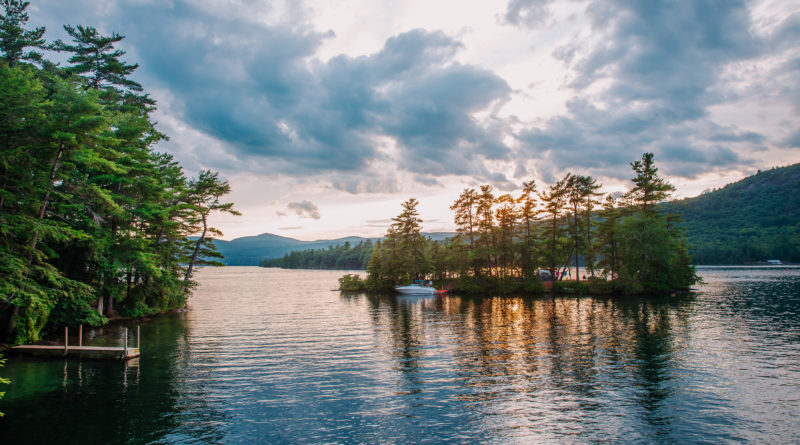Island Camping on Lake George
All photos by Jesse Schloff
“We started going there as kids,” Stowe-based photographer Jesse Schloff remembers. “My parents would pile us all into this cabin cruiser and we would head out to one of the islands,” he says of his summer vacations camping on the islands of Lake George.
Nearly 30 years later, Schloff and his own family have kept up the ritual, traveling south from their home in Stowe each year. “We’ve gone with my parents, Merle and Katherine, and we’ve gone with our kids, Josi and Aksel. And now we’re bringing friends too.”
Vermonters have a tendency to go north, east and west for their vacations. The wilds of the Northwoods, the coasts of Maine and New Hampshire, the lakes and high peaks of the Adirondacks beckon.
Yet nestled among the Adirondacks, the town of Lake George is just an hour’s drive from Rutland. It has the feel of a bustling summer resort village. The homes on Lake George range from seasonal camps to grand affairs, escapes for city dwellers.
But the islands of Lake George? As Jesse’s wife Kim says, “You can be out there on some islands and feel completely remote.”
 More than 10,000 years ago, glaciers carved a long narrow path through the spine of the eastern Adirondacks, leaving behind Lake George. The lake stretches from Fort Henry, near Fort Ticonderoga and runs 32 miles south to the town of Lake George. It reaches a depth of nearly 200 feet. “There’s no farming or run-off so the water is usually crystal clear,” says Kim. The state of New York owns 44 islands of the more than 170 islands in the lake and hosts 387 shoreline campsites.
More than 10,000 years ago, glaciers carved a long narrow path through the spine of the eastern Adirondacks, leaving behind Lake George. The lake stretches from Fort Henry, near Fort Ticonderoga and runs 32 miles south to the town of Lake George. It reaches a depth of nearly 200 feet. “There’s no farming or run-off so the water is usually crystal clear,” says Kim. The state of New York owns 44 islands of the more than 170 islands in the lake and hosts 387 shoreline campsites.
Those campsites book fast. “The last time we went, we wanted to bring friends so were looking for multiple campsites on one island,” says Jesse. They started booking in January, scouring the descriptions for islands that have a dock for boats, plenty of place to spread out and waters deep enough to plunge into.
The islands are divided into three groups. Long Island is a 100-acre island at the south end of the lake, a short trip from shore and has over 80 campsites on it. These often fill up last and are easiest to book.
The Glen Island Group is just off Bolton Landing where the ranger station is fairly close to town. These are smaller islands with campsites for up to six. Some are just for two or four. To the north of the Glen Island group are the Narrow Islands, which include the Mothers Bunch on the eastern shore of the lake at the base of Black Mountain. Some of these islands are large enough to allow up to six people per campsite, but on some of the smaller islands, campers are restricted to only two or four per site.
“Each of the groups has their own personality and part of the fun is staying on different islands,” says Jesse. “Some are really good for a couple that wants to get away. The Mothers are good because you can access the hikes on Black Mountain and the Glen island and Long Island sites are better for groups or families.”
 For their 2019 trip (pictured here) the Schloffs and their friends settled on Uncas Island, in the Glen Island Group. “It’s close enough to the ranger station on Glen Island and the little store there that we could head over for an ice cream,” says Kim.
For their 2019 trip (pictured here) the Schloffs and their friends settled on Uncas Island, in the Glen Island Group. “It’s close enough to the ranger station on Glen Island and the little store there that we could head over for an ice cream,” says Kim.
“We’d been boat camping with these friends on the Waterbury Reservoir so they knew what to expect and we’ve gotten pretty good at knowing what to bring – and not bring – to keep kids happy,” says Kim.
“The key is just because you are arriving by boat doesn’t mean you should bring too much stuff,” she says. Simple craft projects like friendship bracelets were packed for the kids, inner tubes and water skis for the adults. “Part of the fun for the kids was having them help plan the trip, think about what they wanted to pack and then when we got there, to have them set up their own campsites.”
The islands include firepits, tent platforms and some have privies. “We’d play in the water or visit other islands by day and then gather around the campfire and cook these amazing dinners over a fire at night,” Kim says.
The Schloffs would also take their boat to cruise the shoreline. “One of the things I loved the most was just seeing the amazing homes along the shoreline and the history of this place,” says Jesse.
The Mohicans camped along the lake and on Mohican Point in Bolton Bay before being displaced as Europeans arrived. Andia-ta-roc-te, was the native name for the lake. French Jesuit missionary Father Issac Joques named it “Lac du Sacrement” when he came up on it in 1646 and the lake was finally named for Britain’s King George II in 1755
In 1775, the lake was the site of the Battle of Lake George and one of the first victories for the British in the French and Indian War. James Fenimore Cooper’s The Last of the Mohicans is set largely in Lake George in the 1750s.
 It is the perfect book to read in a hammock swinging from a pine on a summer afternoon. Or before you visit the overlook to Cooper’s Cave, where Hawkeye, one of Cooper’s characters, hid out. For more history, the Lake George Conservancy hosts weekly talks on the region.
It is the perfect book to read in a hammock swinging from a pine on a summer afternoon. Or before you visit the overlook to Cooper’s Cave, where Hawkeye, one of Cooper’s characters, hid out. For more history, the Lake George Conservancy hosts weekly talks on the region.
For Jesse though, it’s the classic boats and fine homes along Millionaire’s Row on Route 9N near Bolton Landing that make touring the lake and the area so interesting. In the late 1800s New York’s wealthiest began building summer “camps” on Lake George. Some, like The Sagamore are now resorts. Others, new and old are private homes; their broad porches and gabled windows looking out over crisp lawns and the lake below.
One of the status symbols on the lake, then and now, is a Hacker boat. Designed by John Hacker who lived and worked in the early 1900s, the boats were made on the lake of mahogany and varnished with coat after coat until they gleam.
Hacker designed the first V-hull and built the first motorboat to hit 50 mph, the Kitty Hawk II. The old boats have become collectors’ items and new boats, still built in Fort Ticonderoga, cost upwards of $300,000.
“Often we would simply cruise the lake and look at all these gorgeous old boats pass by,” says Jesse.
They may not have had Hacker craft, but the Schloffs and their friends trailered their boats to the lake, launched them and kept them tied up at the docks that come with many of the islands. “It can get really windy and wavy on this lake,” Jesse warns.
And on those days, they stayed ashore, hunkered down and made the most of island camping.
How To Camp on Lake George’s Islands
Perhaps the hardest thing about camping on Lake George’s islands is to get a reservation. Many people book way ahead but often, cancellations happen and you can find a spot for the coming weekend. If you are going with a group, the Schloffs recommend starting a search in January. “But you can also call the ranger stations and see if there are cancellations,” Jesse notes. The Glen Island Group is open for reservations through Oct. 11 while the others shut down on Sept. 6.
All campsites are regulated by the Adirondack State Park and have rangers that regularly check the sites. Of the 387 sites, 85 sites are located in the Narrow Island group, 170 sites and 42 cruiser sites are in the Glen Island group (The Narrows), and 90 sites are on Long Island. The 42 cruiser sites are for large boats with sleeping quarters.
Some 25 sites in the Glen Island group are located on the mainland but are accessible by boat only. Most sites are well forested and private. All sites have a dock for one boat, a fireplace, picnic table, and toilet facility or privy but you will need to bring your own firewood or charcoal. Cruiser sites also provide a charcoal burner and privy. For more information and detailed descriptions of the individual campsites, see www.lakegeorge.com/camping/reservations. Campsites are usually $28 a night or $196 a week.
The lake is 3 miles wide in spots and while you can certainly kayak to many of the islands be prepared for high winds and big waves, similar to what you might encounter on the broad parts of Lake Champlain.
You don’t need your own boat and can rent motorboats from several lake-side marinas (see www.lakegeorge.com/local-community-services/boat-services-sales/marinas/). Chic’s rents Boston Whalers that can take 5 for about $425 a day. Call ahead though as boats sell out quickly. The Lake George Kayak Company in Bolton Landing also rents kayaks for $85 a day for a double.
Though Lake George’s antique boat museum is no longer open, this year the Lake George Antique Boat Show is Aug. 27-28. And for more on the history of the region, The Lake George Land Conservancy has a Living Lands Series of weekly talks.

